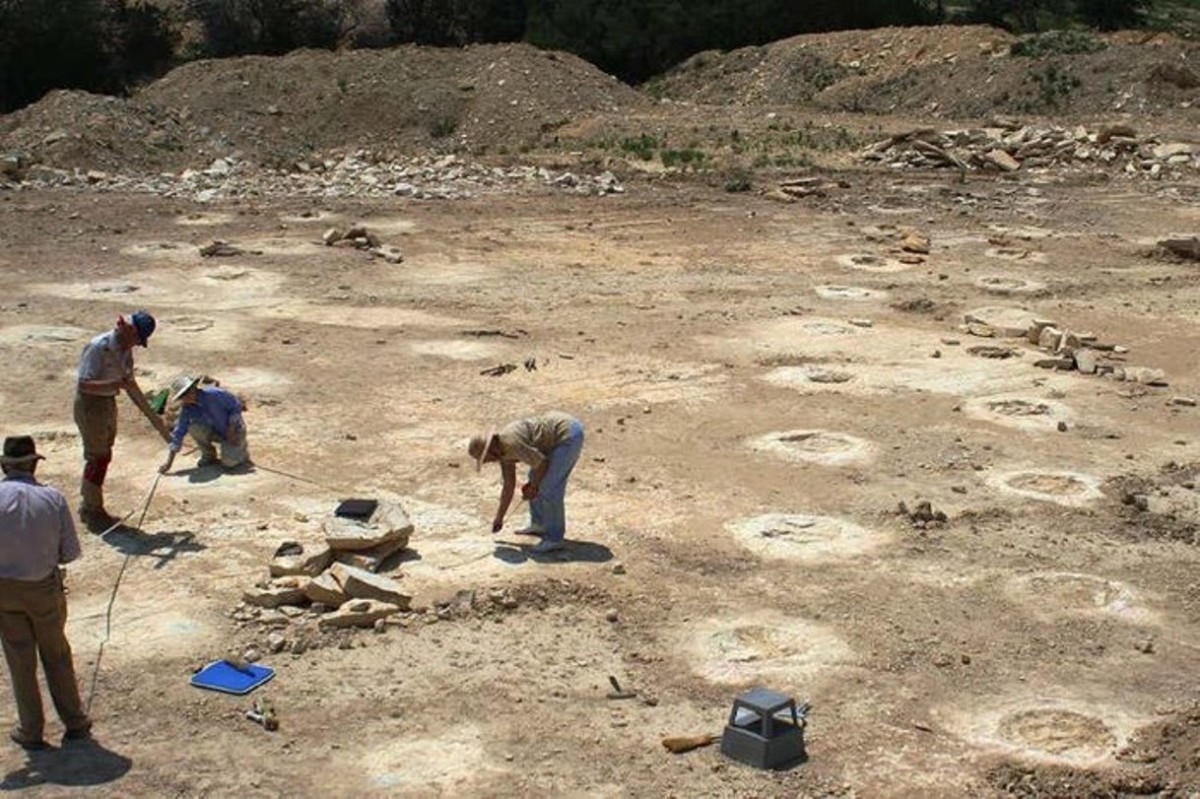Thunder lizard handstands

More than 60 well-preserved footprints appear to show three sauropod dinosaurs ‘walking’ in water, using their forelimbs only.1 Discovered in a limestone quarry in the Glen Rose Formation, Texas, the Coffee Hollow dinosaur tracksite consists of three parallel trackways heading in the same direction.
The tracks are shallow—only a few centimetres deep. Amazingly, these dinosaurs left tracks in the mud only with their forefoot (manus, Latin for ‘hand’). They left no trace of any print from their hindfoot (pes, Latin for ‘foot’). The dinosaur prints on the outer two trackways were up to 70 cm wide—25–35% larger than those in the middle. The middle tracks were also particularly faint.
The research team discussing the find1 believes the layer was under water when the footprints were made. The layer directly above, which also filled the footprints, showed ripple marks. These in turn must have been buried soon after, to cement them in place before they could be erased.
Two options
The researchers gave two explanations for the forefeet-only trackway. The first involved the centre of mass of the dinosaur being closer to its front. The researchers believed that this led to greater pressure being exerted by the forefeet leaving footprints, and with less weight on them, the hindfeet did not. Think of the famous WW2 Supermarine Spitfire fighter plane, its heavy engine, weapons, and the main landing wheels all towards the front. The small light landing wheel at the rear of the plane supported very little weight.

However, the sauropod dinosaurs which possibly made the tracks “may have been 25 metres or more in length and weighed 15 to 78 tonnes”.2 At this size and weight, they did not exactly have a light rear end. The other major flaw in such a proposal is that “in presently known sauropod trackways from the Glen Rose Formation that consist of both manus and pes prints, whether faintly/shallowly registered or deeply impressed, the manus prints are not more deeply impressed than pes prints.” 3
The second option makes more sense: the dinosaurs were wading in water up to their shoulders. They used their forefeet to ‘punt’ themselves along, leaving the shallow impressions in the mud as their forefeet just touched the bottom. Indeed, a number of previous studies have highlighted that “the location of the centre of buoyancy relative to the centre of mass in certain sauropods … would cause the hindquarters of a wading dinosaur to lift off the bottom while the forefeet were still pushing against the substrate. Such a punting sauropod might then be able to glide with its body supported by the water … this might also result in shallowly impressed manus prints.”4 In other words, the sauropod body plan would force them to do handstands in deep enough water as they tried to move forward.

The best explanation
The trackways fit well with the dinosaurs pulling themselves through the waters of the Noahic Flood some 4,500 years ago while trying to find dry land. The smaller sauropod in the middle was struggling to keep its head above the deep water and get a foothold. This explains why its prints were fainter. Shortly after leaving their forefoot impressions, these were covered quickly by another layer of sediment, preserving the sauropods’ watery interaction. Another layer soon followed.
References and notes
- Farlow, J.O. and 8 others, Thunder lizard handstands: Manus-only sauropod trackways from the Glen Rose Formation (Lower Cretaceous, Kendall County, Texas), Ichnos 27(2):167–199, Apr 2020; published online 13 Dec 2019. Return to text.
- Barras, C., Giant dinosaurs may have crossed water using just front feet, New Scientist, 1 Feb 2020, p. 16. Return to text.
- Ref.1, p. 22. Return to text.
- Ref.1, p. 28. Return to text.






Readers’ comments
Comments are automatically closed 14 days after publication.